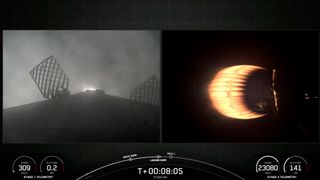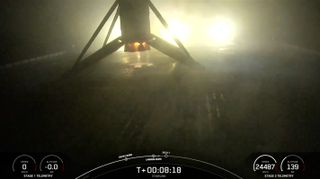SpaceX launched 20 more of its Starlink broadband satellites, including 13 with direct-to-cell capability, from California early Wednesday morning (Sept. 25).
A Falcon 9 rocket carrying 20 Starlink spacecraft lifted off from Vandenberg Space Force Base, on California's central coast, on Wednesday at 3:01 a.m. EDT (0701 GMT; 9:01 p.m. on Sept. 24 California time).
The Falcon 9's first stage came back to Earth 8.5 minutes after liftoff as planned, landing on the SpaceX drone ship "Of Course I Still Love You" in the Pacific Ocean.

It was the 10th launch and landing for this particular booster, according to a SpaceX mission description.
The Falcon 9's upper stage, meanwhile, continued powering its way to low Earth orbit, where it's scheduled to deploy the 20 satellites 60 minutes after liftoff. The newcomers will join the Starlink megaconstellation, which consists of more than 6,300 active spacecraft.
Related: Starlink satellite train: How to see and track it in the night sky

The Starlink launch was part of a typically busy week for SpaceX. Elon Musk's company aims to launch the Crew-9 astronaut mission to the International Space Station (ISS) for NASA on Saturday (Sept. 28), sending it aloft via a Falcon 9 from Florida's Cape Canaveral Space Force Station.
Get the Space.com Newsletter
Breaking space news, the latest updates on rocket launches, skywatching events and more!
Crew-9 isn't your typical ISS astronaut mission. It will launch with two crewmembers instead of the usual four, because it will take home to Earth two people already living on the ISS — NASA's Suni Williams and Butch Wilmore, who arrived in June aboard Boeing's Starliner capsule.
Starliner suffered thruster issues on its way to the ISS, and NASA decided to bring the spacecraft home uncrewed as a result. Williams and Wilmore will come home with the two Crew-9 astronauts — NASA's Nick Hague and Aleksandr Gorbunov, of Russia's space agency Roscosmos — aboard the SpaceX Crew Dragon capsule "Freedom" in February 2025.
Editor's note: This story was updated at 12:30 a.m. ET on Sept. 24 with news of successful launch and rocket landing.
Join our Space Forums to keep talking space on the latest missions, night sky and more! And if you have a news tip, correction or comment, let us know at: community@space.com.

Michael Wall is a Senior Space Writer with Space.com and joined the team in 2010. He primarily covers exoplanets, spaceflight and military space, but has been known to dabble in the space art beat. His book about the search for alien life, "Out There," was published on Nov. 13, 2018. Before becoming a science writer, Michael worked as a herpetologist and wildlife biologist. He has a Ph.D. in evolutionary biology from the University of Sydney, Australia, a bachelor's degree from the University of Arizona, and a graduate certificate in science writing from the University of California, Santa Cruz. To find out what his latest project is, you can follow Michael on Twitter.